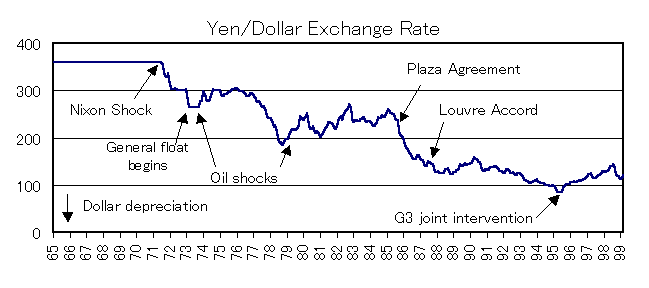
(See handouts nos.2 & 3)
Since 1973 to present, the major currencies in North America, Europe and Japan have been floating for more than three decades. During this period, exchange rate instability among major currencies was the norm. While the US dollar continues to be the most popular international currency, there is no more guarantee that the US will always play a positive role in stabilizing the international monetary system. While the US remains economically dominant, its occasionally unilateral behavior has become a major disturbing factor in the world economy. Meanwhile, EU and Japan (especially the latter) are not powerful enough to overtake the dollar's dominant position. John Williamson of the Institute of International Economics (Washington, DC) calls the current floating exchange rate regime the "non-system."
The policy management of the floating rate system changed significantly before and after 1985. Before 1985, currency fluctuation was considered generally desirable, although somewhat unstable. After 1985, it was recognized that free floating sometimes became too volatile, and joint intervention to stabilize the foreign exchange market was at times deemed necessary.
From the early 1970s to the early 1980s, the world economy suffered a serious "stagflation" (coexistence of high inflation and output stagnation). Prices and interest rates rose and diverged across countries. There were also two "oil shocks" in 1973-74 and 1979-80, both associated with instabilities in the Middle East. The oil price increased greatly and major oil producers curtailed its supply (including the oil embargo to unfriendly countries).
Many industrial countries experienced low (even negative) growth, productivity slowdown, higher unemployment and fiscal crisis. The important thing was that these macroeconomic shocks were common to all countries.
During this turbulent time, major exchange rates also showed great instability. Floating currencies did not move smoothly in response to changing fundamentals. Rather, they exhibited short-term volatility, medium-term misalignment and long-term drift. This meant that floating rates did not necessarily provide an automatic adjusting mechanism (as the advocates of free floating believed). Exchange rate instability itself became a serious shock to the world economy. Economists began to wonder why.
The daylight saving time argument for floating exchange rates: Milton Friedman, the king of monetarism and a relentless freedom defender, argued for exchange rate flexibility in 1953 as follows: "Isn't it absurd to change the clock in summer when exactly the same result could be achieved by having each individual change his habits? All that is required is that everyone decide to come to his office an hour earlier, have lunch an hour earlier, etc. But obviously it is much simpler to change the clock that guides all than to have each individual separately change his pattern of reaction to the clock ... The situation is exactly the same in the exchange market. It is far simpler to allow one price to change, namely, the price of foreign exchange, than to rely upon changes in the multitude of prices that together constitute the internal price structure." Later in 1989, Paul Krugman also wrote: "What a currency depreciation does is solve the coordination problem. When the dollar falls against the yen and the ecu, all U.S. wages fall together and simultaneously, with no need for anyone to cut a nominal wage." However, McKinnon and Ohno (1997) criticized this line of thought by saying that exchange rate changes were not so neutral since different wages and prices reacted differently to the same depreciation, which upset domestic price structure.
After the breakdown of the Bretton Woods system in the early 1970s, the dollar depreciated against other currencies. Then it stabilized a while. But it began to depreciate greatly in 1977-78 until an emergency dollar rescue package was implemented in November 1978. After that, the dollar gradually appreciated until 1985, damaging the international competitiveness of US firms. Gradually, the world began to move toward harnessing the excessive movement of the major currencies. But returning to the fixed exchange regime remained out of question for a majority of policy makers.

There was a hot debate regarding the cause of global economic slowdown in the 1970s-80s. Many economists blamed the supply shocks (especially the oil shocks and wage rigidity) for global slowdown. They considered it lucky that the world had made the transition to a floating rate regime by the time of the oil shocks so that the negative impact could be absorbed more smoothly. But some economists, including Ronald McKinnon and Robert Mundell, disagreed. They emphasized the shift in monetary and exchange rate regime (i.e., the breakdown of the Bretton Woods system) as the major cause of global inflation and recession. For them, the oil shocks were the result of global monetary instability and not the cause. For more, see lecture 12 of Economic Development of Japan (or my book, Economic Development of Japan, pp.186-189).
|
Debate on the Oil Shocks of the 1970s |
||
| Supply Shock View | Global Monetarist View | |
| Cause | The main cause was OPEC's political power to raise oil prices. Wage rigidity in oil-importing countries (especially Europe) further worsened the situation. Together, they pushed up the aggregate supply curve, simultaneously generating inflation and recession. | When the Bretton Woods System broke down, Japanese and European central banks intervened heavily to prop up the dollar and greatly increased money supply. The resulting global liquidity overhang caused world inflation. OPEC oil price hike was the result and not the cause. |
| Cure | Solve supply side problems through energy efficiency, oil storage and wage flexibility. | Install a global nominal anchor (mechanism to avoid global monetary expansion) through international policy coordination. |
| Evaluating int'l monetary system | The transition to general floating prior to the oil shocks helped the adjustment process. Floating exchange rates are much better for absorbing supply shocks. | The lack of a global nominal anchor (especially US macroeconomic discipline) was the cause of both the collapse of the Bretton Woods system and the following global inflation. |
| Advocates | Jeffrey Sachs, Michael Bruno, Barry Bosworth... | Robert Mundell, Ronald McKinnon, Hans Genberg, Alexander Swoboda... |
Since the 1970s, the design and revision of the international monetary system was handled by a group of industrial countries bilaterally, regionally, or multilaterally. Their cooperation (or the lack of it) has determined the evolution of exchange rates. By contrast, IMF has not shown much interest or leadership in stabilizing or improving the international monetary system. In the late 1970s, IMF endorsed the floating rate regime as the most realistic solution, albeit imperfect.
In September 1985, the finance ministers of the G5 countries (US, Japan, Germany, France, UK) gathered at Plaza Hotel (next to Central Park in Manhattan, New York) and decided to lower the dollar which was clearly overvalued (the Plaza Agreement). The US government, which had so far been reluctant to intervene in the currency market because of the free market philosophy, also agreed to cooperate. The joint intervention of these countries was very effective, depreciating the dollar's value from 240 yen to 140 yen, and from 2.8 DM to 1.8 DM within a year and half. Some claim that the dollar's decline already began a few months before the Plaza Agreement. But the announcement effect of the policy change on a global scale was undeniable.
However, the dollar continued to slide beyond the level which was comfortable for Japan and Germany (especially the former). In February 1987, the economic leaders of the G7 countries (G5 plus Italy and Canada) met in Paris to stop the further fall of the dollar (the Louvre Accord). After that, the yen stabilized in the 120-150 range against the dollar.
The Plaza-Louvre cooperation marked the new era of managing floating exchange rates. Previously, free floating was considered ideal and the US was particularly unwilling to intervene. But after these meetings, the major countries began to cooperate a bit more. And this regime still continues today.
The Plaza-Louvre regime can be summarized as follows.
|
The Plaza-Louvre Regime: RULES OF THE GAME |
|
| 1. | Unannounced, soft, variable and broad target zones for the major currencies (especially yen/dollar and euro/dollar) are imagined. Target zones can be revised if economic fundamentals change. |
| 2. | During the normal time when the exchange rates lie within these zones, let the market decide the currency levels. |
| 3. | Intervene jointly, but infrequently, if the actual rates are moving out of these zones. Do not hide these interventions. |
| 4. | Not only Japan and EU, but also the US should participate in these currency interventions in a symmetrical manner. |
| 5. | Interventions must be sterilized (i.e., do not permit the domestic money supply to change because of currency interventions). |
| 6. | Capital mobility must be preserved (current-account and capital-account convertibility). |
| 7. | Other than the above, each country should use macroeconomic policies to pursue domestic goals. |
In the summer of 1995, in the spirit of the Plaza-Louvre regime, the major countries jointly intervened aggressively to support the collapsing dollar, which eventually turned around and began to appreciate. Apart from this, smaller joint interventions have become more common, although still infrequent.
It is often argued that with increasing capital mobility, official international reserves are not enough to fight massive speculation and therefore monetary authorities can no longer control exchange rates. It is true that the amount of daily transactions in foreign currencies overwhelms the collective reserve holding of central banks. But that does not necessarily mean that policy is powerless or interventions are useless.
Sometimes intervention works, but other times it does not have any impact on the foreign exchange market. It appears that joint intervention (by many countries) conducted at the critical moment is effective. On the other hand, repeated and predictable interventions by only one country (say, the Bank of Japan) alone usually have little impact.
According to Dominguez and Frankel (see below), there are three possible channels for intervention to work (i.e., influence exchange rates).
(1) Unsterilized intervention: this means that domestic money supply is allowed to change as a result of currency intervention, so the LM curve will shift and will affect the exchange rate through the interest rate channel.(2) Portfolio effect: if the private sector (of the entire world) has a preferred mix of currencies in their financial asset holding, intervention will upset this mix as currency A is bought up for currency B by monetary authorities. This will prompt exchange rate changes to restore portfolio-balance equilibrium.
(3) Signaling effect: if intervention is a signal that a fundamental change in monetary policy will occur in the near future, it will change market expectations and exchange rate levels (provided that the signal is credible).
But in reality, most interventions under the Plaza-Louvre regime have been sterilized, so the first channel does not work. As to the second channel, the calculated portfolio effect is so tiny that it can hardly explain the observed large fluctuations of the yen, dollar, and European currencies. Thus, Dominguez and Frankel conclude that the only way (joint) intervention can influence exchange rates is through the third channel. It works only if intervention is a precursor of a fundamental change in monetary policy to come.
As the yen/dollar exchange rate graph above shows, the yen has had three types of movement against the dollar:
(1) Long-term appreciating trend (throughout 1970s, 80s and part of the 90s)
(2) Medium-term fluctuations (cycles of several years around the long-term trend)
(3) Short-term volatility (monthly, weekly, daily and hourly movements)
 |
The yen's actual course was the combination of these three. Prof. Ronald McKinnon (Stanford University) and I wrote a book to explain the first two movements.
The dollar declined to less than 1/3 of the original nominal value, from 360 yen in 1970 to about 110-120 yen today. Why did the dollar depreciate so much? The conventional view says that this was a result of different economic fundamentals between Japan and the US. For example, (i) Japan had higher productivity growth than the US; (ii) Japan had lower inflation than the US; and (iii) Japan continued to have a huge trade surplus with the US. For these reasons, they say, dollar depreciation against the yen was not only natural but also highly welcome as a macroeconomic adjustment mechanism. Many economists once argued that, in order to reduce Japan's trade surplus with the US, the two governments should actively engineer a continued dollar depreciation (without waiting for the market to do so).
The McKinnon-Ohno hypothesis of the "Syndrome of the Ever-higher Yen" is different from the conventional view. Our explanation of the yen-dollar movement since the 1970s is as follows:
Every several years when the US trade deficit with Japan reaches a politically intolerable level (i.e., when the US Congress and industrial lobbies start to complain), the US government demands two things from Japan:
--Exchange rate pressure: the yen should appreciate against the dollar.
--Bilateral trade negotiations: Japan must buy more from and sell less to the US.
This happened in 1971-73, 1977-78, 1985-87, and 1993-95. As the US high officials talked up the yen, the yen sharply appreciated and the trade tension rose between Japan and the US.But this destabilizes the Japanese and Asian economies without solving the US trade deficit problem. The US deficit is a long-term, structural problem caused by the lack of domestic saving by the American government and private sector. Currency adjustments and trade talks are ineffective and cannot solve this US-made macroeconomic problem. The fundamental solution must come from the US domestic policy to curb consumption, contain the budget deficit and encourage domestic savings.
Surely, Japan should open up its economy and accept more imports from developing countries and FDI from abroad. This will be good for micro and structural reasons. However, it may have little impact on its trade balance which is basically determined by the savings-investment relationship at the macro level (lecture 7).
Despite repeated dollar depreciations since the 1970s, the US trade deficit is as large as ever and still growing. The outcome of forced yen appreciation is depressed prices in Japan and volatility of Japan's price competitiveness. According to our view, it is the policy-induced yen appreciation that caused the fluctuation of macroeconomic fundamentals, not vice versa. Other countries with persistent trade surpluses with the US, such as China, may have a similar problem with the US in the future [now it is already happening].
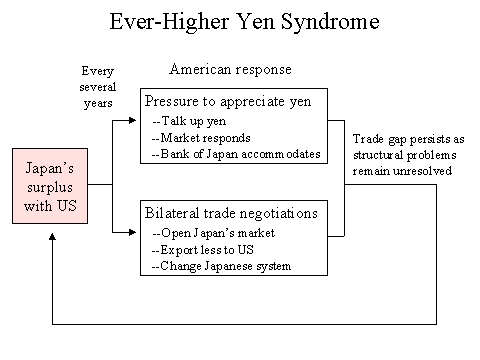
Let us follow the European path toward one currency, step by step.
The snake (1972): the effort toward exchange rate stability and monetary union was started in 1972 immediately after the collapse of the Bretton Woods system. Germany and a few other small countries (Netherlands, Belgium, Denmark) were the core members of the new arrangement, while France, Italy, Sweden, Norway and others joined part of the time. The new system was initially called the "snake in the tunnel" because currency values were kept within 2.5% of each other, and all rates were to be kept within a band of 4.5% against the dollar. But in 1973, the latter constraint was removed. The snake got out of the tunnel.
European Monetary System (EMS, 1979): the snake was enlarged to include the three big countries, Germany, France, Italy, plus others (but UK did not join). At the same time, the Exchange Rate Mechanism (ERM) was installed in which all bilateral pairs of member currencies were fixed within the band of plus/minus 2.25%, while they jointly floated against the dollar. Intervention rules and short-term financing were also specified. The European Currency Unit (ECU), a currency basket of all member countries, was created and its value was determined by a weighted average of the participating currencies.
At first, EMS was operating as a regional adjustable peg system. Since each country's inflation rates were different, it was impossible to keep the rates fixed for a long time. "Realignments" (revision of fixed rates among European currencies) were implemented 11 times. But the frequency of realignments gradually declined during the 1980s. The most realignments involved appreciation of DM and devaluation of FF and Lira.
European Currency Movements Relative to ECU
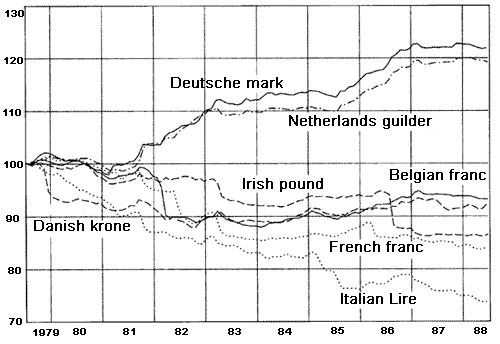
Although all member countries were treated symmetrically, EMS was really a DM-centered system, with the German monetary policy (conducted by the Bundesbank) as the nominal anchor. In the 1980s, Germany had the lowest inflation in Europe so other countries tried to reduce their inflation rates toward the German level. This attempt gradually succeeded, and most countries began to have low inflation. [Some argue that countries outside Europe also had lower inflation during the 1980s, so it was a global trend and not an EMS achievement.]
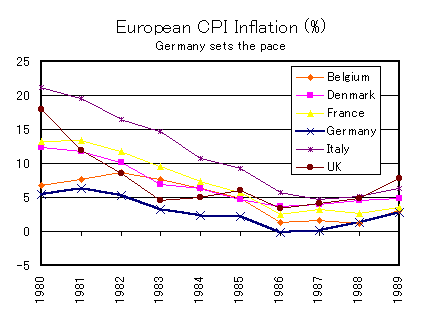
In the process, there was a debate regarding the sequencing of convergence and discipline. People like Britain's Margaret Thatcher argued that macroeconomic indicators must converge within Europe before the attempt was made to fix exchange rates. But others, like the French, contended that narrow exchange rate bands impart policy discipline, which promotes economic convergence. This is a chicken-and-egg question and each view is correct in its way. It is necessary to balance these two factors when designing the sequencing of exchange and monetary union.
Maastricht Treaty (1991): The Europeans spelled out clearly the roadmap toward the final currency unification. In the Maastricht Treaty, three steps were proposed--and later actually implemented.
Stage 1: from 1992, further convergence in inflation, interest rates, exchange rates and fiscal balance was to be achieved. The criteria for convergence were presented.
Stage 2: from 1994, the European Monetary Institute was to be created, and economic surveillance was strengthened.
Stage 3: from 1999, one currency (later named euro) was to be created. EMI was to be upgraded to the European Central Bank.
EMS crises (1992, 1993): But the European currency market was hit by severe speculations soon after this roadmap was agreed. The main reason for this crisis was German unification. Partly because of the inevitable fiscal spending and partly because the unification of West and East Germany was conducted at the wrong exchange rate (1:1), German fiscal policy became expansionary while the Bundesbank (central bank) continued to keep money tight. This macroeconomic combination raised German interest rates, put an upward pressure on DM and downward pressure on other currencies. But other countries facing unemployment problems did not want to "import" high interest rates from Germany. In September 1992, UK and Italy left ERM and started to float. In July/August 1993, France finally permitted a large depreciation of FF.
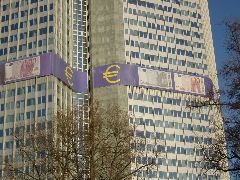 |
|
European Central Bank in Frankfurt |
Because of these crises, regional currency union was considered hopelessly off-track. Many thought that Europe would never have a common currency. But they were wrong. After 1992-93, stability returned to the European currency market relatively quickly, and there were no more currency troubles in Europe. In the end, the Maastricht roadmap was implemented and the Europeans regained confidence in a common currency.
The birth of euro (1999): as scheduled, a new common currency (euro) was created and the European Central Bank (ECB) was established. More precisely, the European System of Central Banks (ESCB) consists of ECB in Frankfurt and the national central banks of member countries. ECB's policy goal is price stability. The harmonized index of consumer prices (HICP) measures the inflation performance of the region. An inflation rate of less than 2% is targeted and money supply is to be used as the reference index. There is no exchange rate targets for ECB (against outside currencies). The authority of and responsibility for fiscal policy and bank supervision are left to national central banks and national governments.
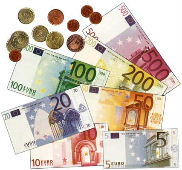 The circulation of euro (2002): euro notes and coins began to
circulate, replacing national monies. This completed the monetary union.
The circulation of euro (2002): euro notes and coins began to
circulate, replacing national monies. This completed the monetary union.
As Europe was making these steps, some economists (like Martin Feldstein) bitterly criticized the idea of monetary union and said that it would never work. These critics were the believers of floating exchange rates and wanted to preserve exchange flexibility among European countries. Other economists accepted--and even praised--the European move, but asked the following questions:
Q1. Will the euro survive?
So far, no problem. But if a big challenge occurs (global depression, severe euro overvaluation, etc.), there may be strain between countries which want a strong euro and those that want euro depreciation.
Q2. Will the euro compete with the dollar as the international currency? Will we have the two-currency world consisting of euro and dollar?
There are two views here: fundamentalists say that the big economic size of Euroland, which is roughly the same as the US economy, will surely take some role away from the dollar. By contrast, those who emphasize the historical momentum say that the dollar's dominance will continue. We still don't know the final outcome, but so far the dollar's dominance has not been undermined.
Q3. Will the euro-dollar exchange rate be stable or volatile?
If the US and EU compete for better monetary management, the world will enjoy price stability and the cross rate between euro and dollar will be stable. But such competition may lead to increased currency swings. Both outcomes are theoretically possible. So far, there does not seem to be clear evidence that the euro-dollar volatility is bigger or smaller than the previous ecu-dollar volatility. In recent years, the euro has been quite strong against the US dollar.
Q4. When will the UK join?
We must wait and see for this. The UK is always cautious about joining schemes that Continental Europe creates. (Every year, I write this in my course web but there has been no clear signal as to when the UK will embrace the euro.)
<References>
Alogokoufis, George, and Ron Smith, "The Phillips Curve, the Persistence of Inflation, and the Lucas Critique: Evidence from Exchange-Rate Regimes," American Economic Review 81:5, 1991, pp.1254-75.
Dominguez, Kathryn, and Jeffrey Frankel, Does foreign exchange intervention work? Institute for International Economics, 1993.
Friedman, Milton, "The Case for Flexible Exchange Rates," in his Essays in Positive Economics, University of Chicago Press, 1953.
Ito, Takatoshi, "Is Foreign Exchange Intervention Effective?: The Japanese Experiences in the 1990s," NBER Working Paper 8914, April 2002.
Ito, Takatoshi, "The Exchange Rate in the Japanese Economy: The Past, Puzzles, and Prospects," Japanese Economic Review 56:1, March 2005.
James, Harold, International Monetary Cooperation since Bretton Woods, International Monetary Fund and Oxford University Press, 1996.
Krugman, Paul, Exchange-Rate Instability, MIT Press, 1989.
McKinnon, Ronald I., The Rules of the Game: International Money and Exchange Rates, MIT Press, 1996.
McKinnon, Ronald I., and Kenichi Ohno, Dollar and Yen: Resolving Economic Conflict between the United States and Japan, MIT Press, 1997 (Japanese translation, Nihon Keizai Shimbunsha, 1998).